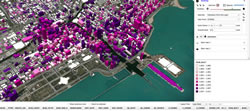HiPACC Data Science Press Room. From: UCB
The Data Science Press Room highlights computational and data science news in all fields *outside of astronomy* in the UC campuses and DOE laboratories comprising the UC-HiPACC consortium. The wording of the short summaries on this page is based on wording in the individual releases or on the summaries on the press release page of the original source. Images are also from the original sources except as stated. Press releases below appear in reverse chronological order (most recent first).
November 5, 2014 — Coexist or perish

Relationship between forest cover, population density and area burned in fire-prone regions. Forest cover is the percentage area covered by trees higher than 5 meters per cell in 2000; population is number of people per cell (log transformed) in 2000; and fire is total area burned in hectares per cell (log transformed) between 1996 and 2012. The color scale for fire is to help differentiate higher peaks in area burned.
UCB/UCSB 11/5/2014—Many fire scientists have tried to get Smokey the Bear to hang up his “prevention” motto in favor of tools such as thinning underbrush and prescribed burns, which can manage the severity of wildfires while allowing them to play their natural role in certain ecosystems. But a new international research review—led by a specialist in fire at UC Berkeley’s College of Natural Resources and an associate with UC Santa Barbara’s National Center for Ecological Analysis and Synthesis—calls for changes in our fundamental approach to wildfires: from fighting fire to coexisting with fire as a natural process.“We don’t try to ‘fight’ earthquakes: we anticipate them in the way we plan communities, build buildings and prepare for emergencies,” explained lead author Max A. Moritz, UCB. “Human losses will be mitigated only when land-use planning takes fire hazards into account in the same manner as other natural hazards such as floods, hurricanes and earthquakes.” The review examines research findings from three continents and from both the natural and social sciences. The authors conclude that government-sponsored firefighting and land-use policies actually incentivize development on inherently hazardous landscapes, amplifying human losses over time. The findings were published in
Nature.
Read full UCB release.
Read full UCSB release.
November 4, 2014 — How important is long-distance travel in the spread of epidemics?
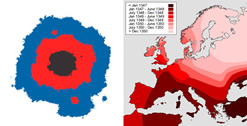
When long-distance travel is rare, epidemics spread like a slow, rippling wave, as demonstrated by the simulation (left) and the actual historical spread of the Black Death during the Middle Ages. Credit: Oskar Hallatschek, D. Sherman, and J. Salisbury
UCB 11/4/2014—The current Ebola outbreak shows how quickly diseases can spread with global jet travel. Yet knowing how to predict the spread of these epidemics is still uncertain, because the complicated models used are not fully understood, says a UC Berkeley biophysicist. Using a very simple model of disease spread, he proved that one common assumption is actually wrong. Most models have taken for granted that if disease vectors, such as humans, have any chance of “jumping” outside the initial outbreak area—by plane or train, for example—the outbreak quickly metastasizes into an epidemic. On the contrary, simulations showed that if the chance of individuals traveling away from the center of an outbreak drops off exponentially with distance—for example, if the chance of distant travel drops by half every 10 miles—the disease spreads as a relatively slow wave. But simulations also suggested that a slower “power-law” drop off—for example, if the chance of distant travel drops by half every time the distance is doubled—would let the disease get quickly out of control. This new understanding of a simple computer model of disease spread will help epidemiologists understand the more complex models now used to predict the spread of epidemics, he said, but also help scientists understand the spread of cancer metastases, genetic mutations in animal or human populations, invasive species, wildfires, and even rumors. The paper appears in Proceedings of the National Academy of Sciences.

View UCB Data Science Press Release
October 27, 2014 — Marvin L. Cohen to receive the Materials Research Society’s highest honor
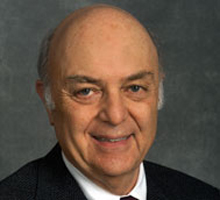
Marvin L. Cohen, 2014 Von Hippel Award recipient
UCB 10/27/2014— The 2014 Von Hippel Award, the Materials Research Society’s highest honor, will be presented to Marvin L. Cohen, University Professor of Physics at UC Berkeley and senior scientist in the Materials Sciences Division of the Lawrence Berkeley National Laboratory. Cohen is being recognized for “explaining and predicting properties of materials and for successfully predicting new materials using microscopic quantum theory.” Cohen is recognized internationally as the leading expert in theoretical calculations of the ground-state properties and elementary excitations of real materials systems. Prior to his seminal work, theoretical studies of solids involved idealized models, but Cohen moved the field toward accurate calculations of real materials, leading to physical theories and computational approaches capable of describing and predicting basic properties of materials.
View UCB Data Science Press Release
October 26, 2014 — Faster switching helps ferroelectrics become viable replacement for transistors
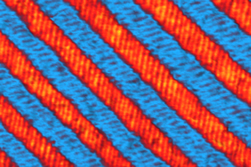
The herringbone pattern of nanoscale domains is key to enabling faster switching in ferroelectric materials. For scale, each tiny domain is only about 40 nanometers wide. Each colored band is made up of many tiny domains. Credit: Ruijuan Xu and Lane W. Martin/UC Berkeley
UCB 10/26/2014— Ferroelectric materials—commonly used in transit cards, gas grill igniters, video game memory, and other applications—could become strong candidates for use in next-generation computers. Because ferroelectrics are non-volatile, they can remain in one polarized state or another without power; that is, information would be retained even if electricity goes out and then is restored, so people wouldn’t lose their data if the power goes off. What has held ferroelectrics back from wider use as on/off switches in integrated circuits? Speed. Now, thanks to new research led by scientists at UC Berkeley and the University of Pennsylvania, an easy way to improve the performance of ferroelectric materials makes them viable candidates for low-power computing and electronics. Their study was published October 26 in
Nature Materials.
View UCB Data Science Press Release
October 20, 2014 — Campus mourns the loss of David Wessel, pioneer in music and science
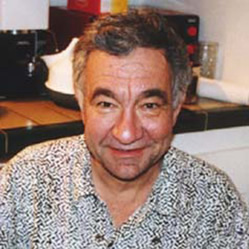
UCB 10/20/2014—David L. Wessel, UC Berkeley professor and a groundbreaking researcher, scholar, and performing artist who thrived in the intersections of music and science, died on October 13 at age 72. Wessel’s early research on the musical role of psychoacoustics—a branch of science that studies psychological and physiological responses associated with sound—laid the foundations for much of his career. His work in the 1970s inspired the creation of some of the first computer software for analyzing, understanding, and using musical material. He championed the use of personal computers for music research and creation while director of pedagogy and software development at IRCAM, an important French institute for research into the science of music and sound and avant-garde electroacoustical art music. He conducted pioneering research in music perception, audio signal processing, and computer music, musical applications of machine learning and neural networks, the design and use of new musical instruments, novel approaches to analysis and synthesis of musical material, and communication protocols for electronic musical devices. He also mentored UC Berkeley students in music, computer science, engineering, statistics, and psychology.
View UCB Data Science Press Release
October 3, 2014 — Three faculty members awarded National Medal of Science
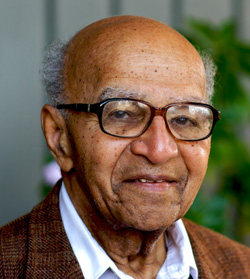
The late David Blackwell, former professor of mathematics and statistics
UCB 10/3/2014—Three UC Berkeley, faculty members were selected Oct. 3 by President Barack Obama to receive the National Medal of Science, the nation’s highest honor for a scientist. Two were mathematicians: Alexandre J. Chorin, 76, University Professor emeritus of mathematics and statistician David Blackwell (who died in 2010 at the age of 91). Chorin, who also is a Senior Faculty Scientist in the Mathematics Group at Lawrence Berkeley National Laboratory, introduced powerful new computational methods for the solution of problems in fluid mechanics. His methods are widely used to model airflow over aircraft wings and in turbines and engines, water flow in oceans and lakes, combustion in engines, and blood flow in hearts and veins. His methods have also contributed to the theoretical understanding of turbulent flow. Blackwell, the first black admitted to the National Academy of Sciences and the first tenured black professor in UC Berkeley history, was a mathematician and statistician who contributed to numerous fields, including probability theory, game theory and information theory. He chaired UC Berkeley’s Department of Statistics and served as president in 1955 of the Institute of Mathematical Statistics, an international professional and scholarly society.
View UCB Data Science Press Release
October 2, 2014 — Why we can’t tell a Hollywood heartthrob from his stunt double

A new study explains the visual mechanism behind our inability to tell actors from their stunt doubles, among other things.
UCB 10/2/2014—Johnny Depp has an unforgettable face. Tony Angelotti, his stunt double in Pirates of the Caribbean, does not. So why is it that when they’re swashbuckling on screen, audiences worldwide see them both as the same person? UC Berkeley scientists have cracked that mystery. Researchers have pinpointed the brain mechanism by which we latch on to a particular face even when it changes. In searching for an exact match to a “target” face on a computer screen, study participants consistently identified a face that was not the target face, but a composite of the faces they had seen over the past few seconds. Moreover, participants judged the match to be more similar to the target face than it really was. While it may seem as though our brain is tricking us into morphing, say, an actor with his stunt double, this “perceptual pull” is actually a survival mechanism, giving us a sense of stability, familiarity and continuity in what would otherwise be a visually chaotic world, researchers point out. The study was published Thursday, Oct. 2 in the online edition of the journal,
Current Biology.
View UCB Data Science Press Release
October 2, 2014 — Cybertools offer new channels for free speech, but grassroots organizing still critical

Kweku Opoku-Agyemang, a Development Impact Lab Postdoctoral Fellow at UC Berkeley’s Blum Center for Developing Economies, explains how the use of mobile technology that automates survey-taking can help expand the political power of the general public in Ghana. Credit: UC Berkeley video produced by Roxanne Makasdjian and Phil Ebiner
UCB 10/2/2014—Communication tools today have changed social movements since the Free Speech Movement of 50 years ago. Online petitions or survey software make it easier for users to register their opinions for elected officials while fast response times enable organizers to orchestrate logistics or respond to developing events. Reported efforts by Chinese officials to censor news of the current pro-democracy protests in Hong Kong by disrupting access to Instagram and removing references to the demonstrations illustrate the degree to which social media is seen as a threat. On the internet, however, every action leaves a trace, opening up the potential for surveillance. Cybersecurity experts have identified malware called Xsser that infects the operating systems of Apple mobile devices. The virus, with code written in Chinese, is capable of stealing text messages, call logs, photos and passwords. Experts believe Xsser is targeting pro-democracy protesters in Hong Kong. Without anonymity, the users are vulnerable to being tracked and persecuted.

View UCB Data Science Press Release
September 30, 2014 — NIH awards UC Berkeley $7.2 million to advance brain initiative

A section of the sensory cortex of a mouse in which cells known as long range projection neurons have been genetically modified to express a green fluorescent protein. John Ngai and colleagues will use single-cell genomics techniques to reveal the diversity of these and other neurons in the brain. Credit: David Taylor and Hillel Adesnik
UCB 9/30/2014—The National Institutes of Health today announced its first research grants through President Barack Obama’s BRAIN Initiative, including three awards to UC Berkeley (UCB), totaling nearly $7.2 million over three years. Among these is a new $5.6 million public-private collaboration between Carl Zeiss Microscopy and UCB to support the Berkeley Brain Microscopy Innovation Center (BrainMIC), which will fast-track microscopy development for emerging neurotechnologies and will run an annual course to teach researchers how to use the new technologies. Part of the Helen Wills Neuroscience Institute, the program will generate innovative devices and analytic tools in engineering, computation, chemistry and molecular biology to enable transformative brain science from studies of human cognition to neural circuits in model organisms.
View UCB Data Science Press Release
September 25, 2014 — Three Bay Area institutions join forces to seed transformative brain research
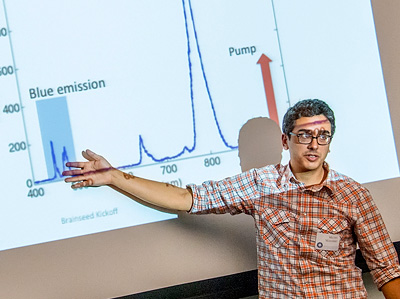
Michel Maharbiz of electrical engineering and computer science describes a project to probe more deeply into the cerebral cortex. Credit: Roy Kaltschmidt/LBNL
UCB 9/25/2014—UC Berkeley, UC San Francisco, and Lawrence Berkeley National Laboratory (LBNL) each put up $1.5 million over three years to seed innovative but risky research in a one-of-a-kind collaboration called BRAINseed. Among their projects is one for development of instrumentation and computational methods. Though great progress has been made in mapping the function of the human brain, researchers have been stymied by limitations in both recording devices and the ability to analyze and understand brain signals. UCSF’s Edward F. Chang, M.D., is leading a team that aims to achieve up to a thousandfold increase in the density and electronic sophistication of recording arrays. The vast amount of data collected by these arrays will be stored and analyzed by some of the world’s most powerful computers at the National Energy Research Scientific Computing Center (NERSC), enabling a new level of understanding of the brain in both health and disease. Chang’s collaborators are Peter Denes and Kristofer Bouchard of LBNL and Fritz Sommer of UCB.
View UCB Data Science Press Release
September 16, 2014 — Human faces are so variable because we evolved to look unique
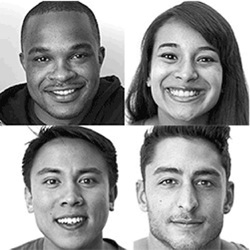
UCB 9/16/2014— The amazing variety of human faces—far greater than that of most other animals—is the result of evolutionary pressure to make each of us unique and easily recognizable, according to a new study by UC Berkeley scientists. They were able to assess human facial variability thanks to a U.S. Army database of body measurements compiled from male and female personnel in 1988. The researchers found that facial traits are much more variable than other bodily traits, such as the length of the hand. They also had access to data collected by the 1000 Genome project, which has sequenced more than 1,000 human genomes since 2008 and catalogued nearly 40 million genetic variations among humans worldwide. Looking at regions of the human genome that have been identified as determining the shape of the face, they found a much higher number of variants than for traits (such as height) not involving the face. They also compared the human genomes with recently sequenced genomes of Neanderthals and Denisovans and found similar genetic variation, which indicates that the facial variation in modern humans must have originated prior to the split between these different lineages. The study appeared Sept. 16 in the online journal
Nature Communications.
View UCB Data Science Press Release
September 15, 2014 — 2014 Berkeley-Rupp Prize for boosting women in architecture, sustainability announced
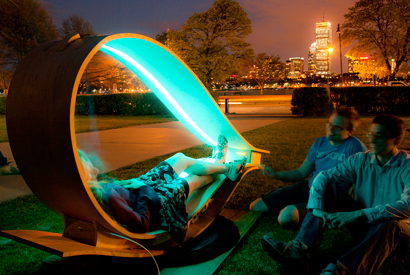
KVA Matx Soft Rockers night time illumination and gathering. Credit: Phil Seaton/Living Photo
UCB 9/15/2014—Sheila Kennedy, an internationally recognized architect, innovator and educator is the 2014 recipient of the Berkeley-Rupp Architecture Professorship and Prize. Awarded every two years, the Berkeley-Rupp Prize of $100,000 is given by UC Berkeley’s College of Environmental Design to a distinguished design practitioner or academic who has made a significant contribution to advance gender equity in the field of architecture, and whose work emphasizes a commitment to sustainability and community. As part of her research, Kennedy will partner with non-governmental organizations (NGOs) to engage communities of fabricators in three developing regions around the world. She will lead UC Berkeley students in computation, architectural design, engineering, and city planning in a series of hands-on design workshops exploring new urban infrastructure. Using soft materials—from paper to wood to bio-plastic—the group will develop open-source digital-fabrication techniques and create adaptable prototypes such as pop-up solar streetlights, soft refrigeration kits for bicycle vendors, and public benches that collect and clean fresh water.
View UCB Data Science Press Release
September 11, 2014 — Changing how we farm can save evolutionary diversity, study suggests

Diversified farms, such as this coffee plantation in Costa Rica, house substantial phylogenetic diversity. Credit: Daniel Karp
UCB 9/11/2014—A new study by biologists at Stanford University and UC Berkeley highlights the dramatic hit on the evolutionary diversity of wildlife when forests are transformed into agricultural lands. The researchers counted some 120,000 birds of nearly 500 species in three types of habitat in Costa Rica, and calculated the birds’ phylogenetic diversity, a measure of the evolutionary history embodied in wildlife. The study, published in the Sept. 12 issue of Science, found that the phylogenetic diversity of the birds fared worst in habitats characterized by intensive farmlands consisting of single crops. Such intensive monocultures supported 900 million fewer years of evolutionary history, on average, compared with untouched forest reserves. The researchers found a middle ground in diversified agriculture, or farmlands with multiple crops adjoined by small patches of forest. Such landscapes supported on average 600 million more years of evolutionary history than the single crop farms. This work is urgent, the authors say, because humanity is driving about half of all known life to extinction—including many species that play key roles in Earth’s life-support systems—mostly through agricultural activities to support our vast numbers and meat-rich diets.
UC Berkeley release
Stanford release:
August 14, 2014 — New tool makes a single picture worth a thousand — and more — images
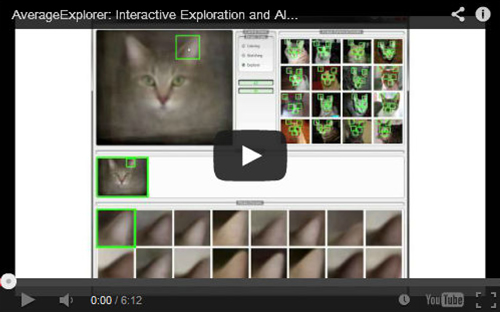
Researchers harness big visual data by creating an average image from thousands of photos. Video by Jun-Yan Zhu, Yong Jae Lee and Alexei Efros, UC Berkeley
UCB 8/14/2014—New software developed by UC Berkeley (UCB) computer scientists seeks to tame the vast amount of visual data in the world by generating a single photo that can represent massive clusters of images. It works by generating an image that literally averages the key features of the other photos. Users can also give extra weight to specific features to create subcategories and quickly sort the image results. “Visual data is among the biggest of Big Data,” said Alexei Efros, UCB associate professor of electrical engineering and member of the UCB Visual Computing Lab. “We have this enormous collection of images on the Web, but much of it remains unseen by humans because it is so vast. People have called it the dark matter of the Internet. We wanted to figure out a way to quickly visualize this data by systematically ‘averaging’ the images.” Efros worked with Jun-Yan Zhu, UCB computer science graduate student and the paper’s lead author, and Yong Jae Lee, former UCB postdoctoral researcher, to develop the system, which they have dubbed AverageExplorer.
View UCB Data Science Press Release
August 4, 2014 — Global economic losses from cyclones linger for decades, study finds

A new study indicates that cyclones over the last 60 years have slowed the annual growth rate of the global domestic product by about 1.3 percent.
UCB 8/4/2014—Economic losses due to hurricanes worldwide continue for decades after disastrous storms strike; moreover, the losses are not alleviated by spending on reconstruction, and may climb with storms that are intensified by climate change. These are among the key findings of a new study that represents the first comprehensive history of global hurricane exposure, analyzing the economic impact of cyclones in painstaking detail. The two coauthors—one a UC Berkeley economist and public policy professor—amassed data with all countries’ exposure to cyclones based on ground-, ship- and satellite-based meteorological observations, and used a physical model to recreate the wind intensity at every point on the planet’s surface for 6,700 cyclones since 1950. Next, they combined this huge dataset with economic datasets for statistical analysis. The study debunks the popularly held belief that environmental disasters disrupt business only for a few months, or at most for a couple of years, and have no long-term effects. On the contrary, when a cyclone hits, in a single day it can undo years of economic development, and reduces per capita incomes by up to 7.4 percent two decades later—akin to rewinding an economy 3.7 years. The findings are laid out in “The Causal Effect of Environmental Catastrophe on Long-Run Economic Growth: Evidence From 6,700 Cyclones,” a working paper released Aug. 4 by the National Bureau of Economic Research (NBER).
View UCB Data Science Press Release
August 4, 2014 — erkeley to host international neuroscience database to speed brain discoveries
UCB/Kavli Foundation 8/4/2014—UC Berkeley, a partner in “Neurodata Without Borders,” will host a neuroscience database to make the digital information more usable and accessible and accelerate the pace of discoveries about the brain in health and disease. The Allen Institute for Brain Science, California Institute of Technology, New York University School of Medicine, the Howard Hughes Medical Institute (HHMI), and UC Berkeley are collaborating on a project aimed at making databases about the brain more useable and accessible for neuroscientists – a step seen as critical to accelerating the pace of discoveries about the brain in health and disease. With funding from GE, The Kavli Foundation, the Allen Institute for Brain Science, the HHMI, and the International Neuroinformatics Coordinating Facility (INCF), the year-long project will focus on standardizing a subset of neuroscience data, making this research simpler for scientists to share.
View UCB Data Science Press Release
July 18, 2014 — Scientists enlist big data to guide conservation efforts
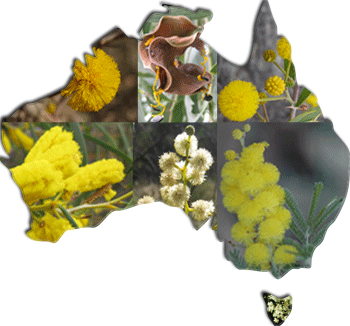
Using data on Australia’s acacia trees, the new model maps areas of endemism—the rainforests of southwest Western Australia, the Gascoyne region and Tasmania—where conservation efforts might preserve rare and endangered species.
UCB 7/18/2014—Despite a deluge of new information about the diversity and distribution of plants and animals around the globe, “big data” has yet to make a mark on conservation efforts to preserve the planet’s biodiversity. But that may soon change. A new model developed by UC Berkeley biologist Brent Mishler and his colleagues in Australia leverages this growing mass of data—much of it from newly digitized museum collections—to help pinpoint the best areas to set aside as preserves and to help biologists understand the evolutionary history of life on Earth. The model takes into account not only the number of species throughout an area—the standard measure of biodiversity—but also the variation among species and their geographic rarity, or endemism. The model, which requires intense computer calculations, is described in the journal
Nature Communications.
View UCB Data Science Press Release
July 11, 2014 — Tapping real-time financial data can improve economic policymaking
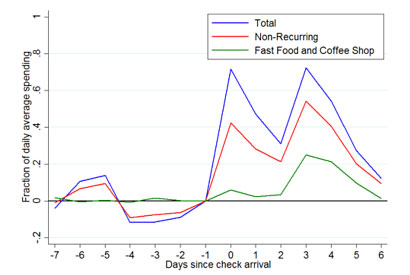
Researchers found spending jumps on the day payments come in, and stay high for several days, reflecting the convenience of paying big bills then. The chart above shows fast-food and coffee shop spending is pretty level all month.
UCB 7/11/2014— Measuring the nation’s economic health has long been a slow, costly and imprecise exercise. Traditionally, economic analysts have been forced to rely on large-scale surveys such as the Consumer Expenditure Survey or the Panel Study of Income Dynamics. But such surveys are complex and expensive to implement, so they are conducted infrequently and with modest-sized samples, with results released after substantial time lags. Because it is now possible to obtain fast, accurate, reliable, detailed, real-time and comprehensive information about daily personal financial spending and saving actions, government agencies and research organizations can capture rapidly-changing economic information generated by households and businesses and adjust course if necessary, UC Berkeley researchers said in a study published in Science. Emmanuel Saez, economist and head of UCB’s Center for Equitable Growth, called the study “pathbreaking” for its use of a dataset with real time and detailed information on incoming and spending, could vastly improve economic policymaking. “This is a great example,” he said, “of how new technologies are generating new big data that can also have incredible value for scientific research.”
View UCB Data Science Press Release
June 24, 2014 — Researcher calls report on economic impacts of U.S. climate change ‘like a flashlight at night’
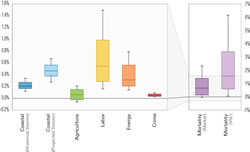
The graphic above indicates the estimated annual economic damages due to climate change in six key sectors of the United States economy.
UCB 6/24/14—UC Berkeley, economist and assistant professor of public policy Solomon Hsiang led the econometrics team that helped assemble a major report American Climate Prospectus: Economic Risks in the United States, released June 24, which projects significant economic risks from climate change in the United States. The first data-driven national study to provide local estimates for economic risks to key economic sectors, it found that: The hardest-hit areas will include heavily-used and increasingly expensive energy sources; labor productivity will also be hard hit as workers are sapped by the heat; infrastructure damage from rising sea levels will surge when combined with hurricane storms; and there is a roughly 50 percent chance that by conducting business-as-usual in terms of climate action, the nation’s climate-related mortality rates will rise to 1 to 3 times that of the motor vehicle mortality rate. While some ot the findings may sound sensational, the report itself is careful to present a balanced picture, said Hsiang, who called it “a hard-nosed risk analysis, produced as if the U.S. were run like a firm.”
View UCB Data Science Press Release
June 16, 2014 — The games genes play: Algorithm helps explain sex in evolution
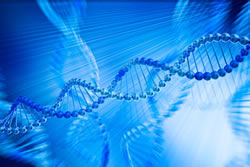
Scientists have identified an algorithm that governs the game genes play during sex. The algorithm helps explain how evolution has yielded the large diversity of life we see today. Credit: Dollarphotoclub
UCB 6/16/14—What do you get when you mix theorists in computer science with evolutionary biologists? You get an algorithm to explain sex. It turns out that 155 years after Charles Darwin first published On the Origin of Species, vexing questions remain about key aspects of evolution, such as how sexual recombination and natural selection produced the teeming diversity of life that exists today. The answer could lie in the game that genes play during sexual recombination, and computer theorists at UC Berkeley have identified an algorithm to describe the strategy used by these genes in this game. Their proposal, published June 16 in the online Early Edition of the Proceedings of the National Academy of Sciences, addresses the dueling evolutionary forces of survival of the fittest and of diversity.
View UCB Data Science Press Release
May 27, 2014 — CNEP researchers target brain circuitry to treat intractable mental disorders
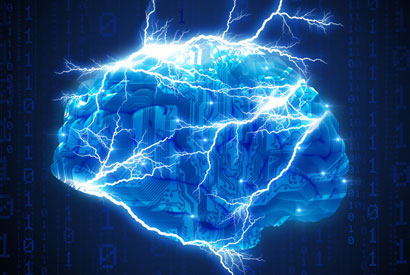
CNEP researchers plan to target malfunctioning neural circuits to treat intractable mental disorders. Credit: iStockphoto
UCB 5/27/14—Neuroscientists, engineers and physicians are teaming up for an ambitious five-year, $26 million project to develop new techniques for tackling mental illness. By using devices implanted in the brain, they aim to target and correct malfunctioning neural circuits in conditions such as clinical depression, addiction and anxiety disorders. The project is funded by the U.S. government’s Defense Advanced Research Projects Agency (DARPA) as part of its Systems-Based Neurotechnology for Emerging Therapies program. The heart of the project lies at the Center for Neural Engineering and Prostheses (CNEP), a UC Berkeley-UC San Francisco collaboration that kicked off in 2011 with a pioneering vision to use engineering techniques to repair neural circuits that have gone awry. Project members will be working under a collaborative agreement between UCSF and DARPA, and in conjunction with scientists from Lawrence Livermore National Laboratory (LLNL), which is receiving separate funding from DARPA as part of this research. The project opens up the possibility that maladaptive circuits can be permanently changed, essentially curing patients of their psychiatric disorders.
View UCB Data Science Press Release
May 21, 2014 — Scientists demonstrate improved catalyst control, energy savings could result
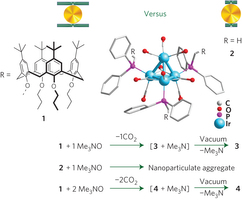
Synthesis and schematic mechanical model of ligand stabilized open-site clusters. Credit: Nature Nanotechnology 9, 459–465 (2014)
UCB/UCD 5/21/14 — Inspired by how enzymes work in nature’s biological processes, researchers have demonstrated a way to improve control of synthetic catalysts. Catalysts accelerate chemical reactions so that they go faster and use less energy. In the research, sponsored by the U.S. Department of Energy, the scientists showed how to switch molecular bonding—the interaction that holds assemblies of atoms together—off and on at will at specific locations within the catalyst. The discovery, researchers said, has potentially profound implications for chemical conversions involving metal catalysts, including pollution abatement. A paper co-authored by Alexander Okrut and Alex Katz of UC Berkeley and Bruce Gates of UC Davis along with University of Alabama computational chemist David Dixon and his graduate student Shengjie Zhang was published in a recent online issue of the journal
Nature Nanotechnology.
View UCB/University of Alabama press release.
May 14, 2014 — Central Valley groundwater depletion raises Sierra and may trigger small earthquakes

Central Valley groundwater depletion raises Sierra and may trigger small earthquakes. GPS measurements show that the Sierra Nevada and Coast Ranges rise several millimeters per year (red dots) as a result of groundwater pumping in the Central Valley (brown). Blue dots are sites where the ground has subsided.
UCB 5/14/14—Winter rains and summer groundwater pumping in California’s Central Valley make the Sierra Nevada and Coast Ranges sink and rise by a few millimeters each year, creating stress on the state’s earthquake faults that could increase the risk of a quake. Millimeter-precision measurements of elevation with improved continuous GPS networks and satellite-based interferometric synthetic aperture radar (InSAR measurements revealed a steady yearly rise of the Sierra of 1-2 millimeters per year. In response to the current drought, about 30 cubic kilometers (7.5 cubic miles) of water were removed from Central Valley aquifers between 2003 and 2010, causing a rise of about 10 millimeters (2/5 inch) in the Sierra over that time. Similar levels of periodic stress, such as that caused by the motions of the moon and sun, increase the number of microquakes on the San Andreas Fault, which runs parallel to the mountain ranges. If these subtle seasonal load changes are capable of influencing the occurrence of microquakes, it is possible that they can sometimes also trigger a larger event.
View UCB Data Science Press Release
April 23, 2014 — Planning professor-turned-entrepreneur to help SF tackle urban problems with Big Data
UCB 4/23/14 — Paul Waddell, a city planning professor at UC Berkeley with a penchant for conducting research with what he calls “big urban data,” is putting his work to a real-world test in San Francisco. His high-tech startup Synthicity will work with the San Francisco Planning Department on new simulation, planning and urban development tools and technologies. Waddell has teamed up with specialists in 3D computer graphics and students in city and regional planning to develop UrbanCanvas, a new platform for designing and visualizing alternative development projects and zoning policies, in conjunction with a 3D visualization platform called GeoCanvas that interprets massive urban datasets quickly and interactively.
View UCB Data Science Press Release
April 18, 2014 — Student ‘hackers’ design new ways to research the Free Speech Movement

A four-student team designed this first-place interface for the FSM Digital Archive.
UCB 4/18/14 — In the half-century since UC Berkeley’s Free Speech Movement (FSM), the rousing oratory of Mario Savio and iconic images of mass demonstrations have come to stand in for the 1964 movement and its legacy. The FSM Digital Archive—a large trove of texts, images and audio recordings that the Bancroft Library digitized and published to the Web in the mid-1990s—was one of the Bancroft’s first forays into digital archiving. But it has technical limitations: Researchers can download and read files one at a time, but there’s no way to analyze the archive as a single data set as scholars in the “digital humanities” and “digital social sciences” are now doing — harnessing computer power to look for patterns across bodies of text, carry out computational analysis, or visualize information in new and compelling ways. For a “hackathon” called HackFSM, organized by the Bancroft Library and Digital Humanities @ Berkeley, students were invited to develop a user interface to make primary-source FSM materials more accessible to researchers and the public.
View UCB Data Science Press Release
April 14, 2014 — Can new understanding avert tragedy?
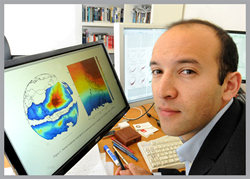
Integrating results from dozens of studies, Sol has shown strong links between temperature change and spikes in human conflict. (Credit: Photo Peg Skorpinski)
UCB 4/14/14 — Sol Hsiang applies complex statistical strategies to examine sobering, large-scale versions of the same basic question: How will environmental change affect life? Hsiang’s expertise lies in finding the connections between seemingly unrelated sources of data needed to answer disquieting questions: What is the likely impact of climate change on global patterns of conflict and on family survival? As research increasingly points to a global temperature rise in coming decades, dozens of forecasts examine the potential impacts on health, agriculture, water supply and migration. But beneath these disruptions lies the possibility of greatly increased localized crime and regional conflict. “One thing we found from looking at all these studies together that no one had pointed out is that unusually cold epochs and unusually warm periods are both associated with greater conflict,” said Hsiang.
View UCB Data Science Press Release
April 3, 2014 — At Berkeley, experts mine questions of Big Data, power and privacy

Deirdre Mulligan: Looking at how information is “crossing borders and boundaries.”
UCB 4/3/14 — In response to President Obama’s call for a review of privacy issues in the context of increased digital information and the computing power to process it, UC Berkeley co-hosted an all-day workshop “Big Data: Values and Governance” with the Office of Science and Technology Policy (OSTP). Introducing the first of four panels of experts, Deirdre Mulligan, an assistant professor in the School of Information and co-director of the Berkeley Center for Law and Technology, compared today to the 1970s: another time marked by “breathtaking revelations of government overreaching into private lives, secret data banks with questionable legal authority and at times illicit goals that caught the population off-guard,” as well as “a deep commitment to secrecy.” “What we’re talking about here is power,” said UCB law professor Kenneth Bamberger. “In a world of Big Data, where data is flowing back and forth at all times, from multiple different sources, and no one knows, often, exactly how it’s being used, these questions of power can’t be overcome by simply individual choices.” See also the workshop program at http://www.ischool.berkeley.edu/newsandevents/events/2014bigdataworkshop
View UCB Data Science Press Release
March 17, 2014 — As students embrace new ways to learn, library learns to adapt
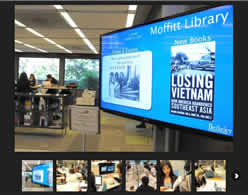
Moffitt Library information gateway and reading lounge
UCB 3/17/14 — At Moffitt Undergraduate Library’s new information gateway and reading lounge, students have access to 2,000 new books, a top-notch computing experience, free digital scanning, reduced-price printing and — starting this semester — a laptop and digital-tablet check-out service.
View UCB Data Science Press Release
March 11, 2014 — Making sense of ‘big data’
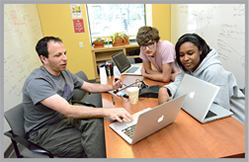
Ben Recht with graduate students Nick Boyd, Electrical Engineering and Computer Science and Ashia Wilson, Statistics. Photo: Peg Skorpinski
UCB 3/11/14 — Big data generates excitement because of its potential to contain answers to important questions. But as Ben Recht knows, often just coming up with the right questions to make sense of a mountain of data is tough. As an assistant professor of statistics and of electrical engineering and computer science, Recht’s work in the NSF-funded Algorithms, Machines, and People (AMP) Lab focuses on simplifying data analysis and developing strategies for solving problems common to many data investigations.
View UCB Data Science Press Release
March 6, 2014 — Preschoolers outsmart college students at figuring out gizmos
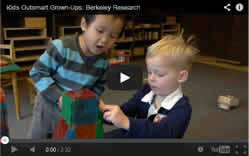
A new study shows children can sometimes outsmart grownups when it comes to figuring out how gadgets work because they’re less biased in their ideas about cause and effect. (Video by Roxanne Majasdjian and Philip Ebiner) https://www.youtube.com/watch?feature=player_embedded&v=bHQ0DemKcEA
UCB 3/6/14 — Preschoolers can be smarter than college students at figuring out how unusual toys and gadgets work because they’re more flexible and less biased than adults in their ideas about cause and effect, according to new research from UC Berkeley and the University of Edinburgh. Overall, the youngsters were more likely to entertain unlikely possibilities to figure out what makes a device work. That confirmed the researchers’ hypothesis that preschoolers and kindergartners instinctively follow Bayesian logic, a statistical model that draws inferences by calculating the probability of possible outcomes.
View UCB Data Science Press Release





















